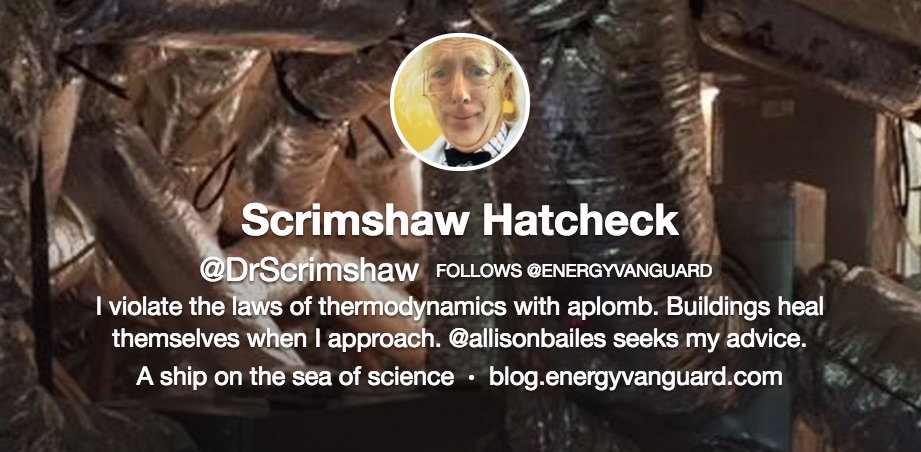Building Science and the Laws of Thermodynamics, Part 3

Thermodynamics is a big subject. It’s complex because you can get to the same conclusions in multiple ways. Just take a look at the different formulations of the second law of thermodynamics. In addition, the laws are macroscopic, meaning we don’t need to know anything about atoms or molecules to justify them. But we can approach them just as easily from the view of kinetic theory and statistical mechanics, as I did when explaining the second law.
For those of us looking at this subject from the building science perspective, it’s all about understanding heat flow. (By the way, heat doesn’t stand still. If it’s not flowing, it’s internal energy. We call this energy heat only when it moves from one object to another. See my article, What IS Heat Anyway?) The first three laws fit into the building science world naturally, but the third law of thermodynamics (which is the fourth, as you know) isn’t something you’re going to make use of in your work on buildings. But it’s still interesting, and you’ll be able to impress friends at parties by citing all four laws.
The third law of thermodynamics
This law actually came about through an analysis of entropy, which was introduced in the second law as one way of understanding what happens when energy degenerates into unusable heat. I’ll skip the entropy discussion here since we didn’t go down that path with the second law. Instead, let’s state the third law in the equivalent form:
The absolute zero of temperature is unattainable.
This law is a direct consequence of the second law. One formulation says that heat engines can never be operated at 100% efficiency, with an equation defining the maximum efficiency as the Carnot efficiency:
e = 1 – TC / TH
TC and TH are the temperatures of the cold and hot reservoirs, respectively. If the cold reservoir were at a temperature of absolute zero, the efficiency would be 100%. But the second law makes it pretty clear that can’t happen. Voilà! We need another law of thermodynamics!
Building science and thermodynamics
To finish this little series up, I’ll summarize the three laws:
Zeroth Law – When two objects are in thermal contact and heat could flow between them but doesn’t, those two objects are in thermal equilibrium.
First Law – Work can be converted to heat and heat to work, but no energy is ever lost in the process. In its most general form, this law says that energy is conserved in all changes among different forms.
Second Law – The flow of heat is always from warmer to cooler objects (Clausius). Also, there’s an upper limit to the efficiency of a heat engine (Carnot).
Third Law – It’s impossible to reach a temperature of absolute zero.
In art, breaking the rules is a big deal. Here’s what Philippe Petit (famous for his daring tightrope walking, as shown in the excellent documentary, Man On Wire) said about rules:
The impossible – we are told – cannot be achieved. To overcome the ‘impossible,’ we need to use our wits and be fearless. We need to break the rules and to circumvent – some would one say to cheat.
And here’s some strange guy on Twitter:
But the laws of thermodynamics aren’t just rules. These are laws of nature. The only way you can break them is by discovering that they’re not correct or perhaps are incomplete. A lot of famous thermodynamicists have traveled this path, though, so you’re probably not going to going to find that loophole. But if you do, please let me know. (I had a guy a few years ago who thought he had something with what he called the Turbo Thermo-Encabulator Max, but the jurie’s still out on that one.)
Well, now you know the four laws of thermodynamics. You even know why the third law is really the fourth and what they have to do with building science. Go out and make use of that knowledge!
Allison Bailes of Atlanta, Georgia, is a speaker, writer, building science consultant, and founder of Energy Vanguard. He is also the author of the Energy Vanguard Blog and is writing a book. You can follow him on Twitter at @EnergyVanguard.
Other Articles in This Series
Building Science and the Laws of Thermodynamics, Part Zero
Building Science and the Laws of Thermodynamics, Part 1
Building Science and the Laws of Thermodynamics, Part 2
Related Articles
Why Doesn’t Heat Flow Backwards?
How the Heck Does a Heat Pump Get Heat from Cold?!
What IS Heat Anyway? – Building Science Fundamentals
NOTE: Comments are moderated. Your comment will not appear below until approved.
This Post Has 2 Comments
Comments are closed.


Sorry Allison, but as an
Sorry Allison, but as an engineer, I don’t have much use for the Third Law, although it is also the basis for the thermodynamic temperature scale. I just can’t make any money trying to get close to absolute zero. I do make money using the First and Second Laws. As for the Zeroth Law, it has limited value for me since I never do seem to be in equilibrium with anyone or anything.
Hi Allison, really pedagogic
Hi Allison, really pedagogic and interesting articles you come up with. Very easy to understand such complex stuff as thermodynamics when you put it all together, thank you for that. Can you explain more of the thermodynamics happening in a doorway, when the door is opened so to speak?